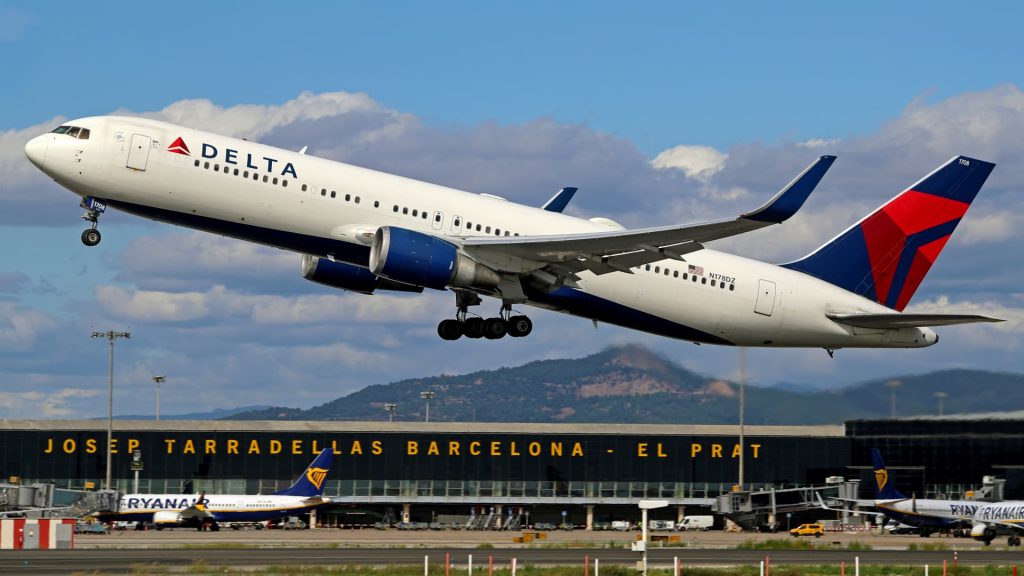Navigating Turbulence: Delta Air Lines Adjusts Course Amid Shifting Travel Demand
Delta Air Lines, a bellwether for the U.S. airline industry, recently released its second-quarter earnings and updated its financial outlook, providing valuable insights into the current state of air travel. While the airline managed to surpass Wall Street expectations for the quarter, a revised profit forecast for 2025 signals a recalibration in response to evolving consumer behavior and industry-wide dynamics. This article delves into Delta’s performance, the factors influencing its revised outlook, and the broader implications for the airline industry.
Key Takeaways from Delta’s Q2 Performance
Despite a challenging environment, Delta Air Lines demonstrated resilience in the second quarter of 2025. The airline reported adjusted earnings per share of $2.10, exceeding the expected $2.05, and adjusted revenue of $15.51 billion, slightly above the forecasted $15.48 billion. This positive performance was driven by several factors:
- Strong Premium Product Sales: Delta benefited from robust demand for its premium offerings, such as first-class seats. This reflects a trend of airlines increasingly catering to affluent travelers willing to pay for enhanced comfort and services.
- American Express Partnership: The airline’s partnership with American Express continued to be a lucrative revenue stream, with revenue from this collaboration increasing by 10% year-over-year to $2 billion.
- Effective Cost Management: Delta’s ability to manage costs effectively contributed to its profitability, despite inflationary pressures affecting various aspects of the airline’s operations.
Revised Profit Forecast: A Sign of the Times
While Delta’s Q2 results were encouraging, the airline revised its full-year earnings outlook for 2025, lowering its adjusted earnings per share forecast to between $5.25 and $6.25. This adjustment reflects a recognition of lower-than-anticipated demand and an industry-wide increase in flight capacity.
Factors Influencing the Revision:
- Shift in Booking Patterns: Consumers are exhibiting a greater tendency to book flights closer to their travel dates. This “wait-and-see” approach introduces uncertainty and complicates airlines’ yield management strategies.
- Hesitant Consumers: Economic uncertainties and lingering concerns related to inflation may be contributing to a more cautious approach to travel spending among some consumers.
- Industry Capacity: An increase in flight capacity across the industry, creates downward pressure on fares and profitability.
- Corporate Travel: Delta’s corporate travel revenue has stablized but is not expected to grow by 5% – 10% as earlier anticipated.
Summer Travel Outlook: A Silver Lining
Despite the overall downward revision, Delta’s outlook for summer travel remained positive, exceeding Wall Street’s expectations. This suggests that while overall demand may be tempered, the peak summer season is expected to be strong, driven by leisure travelers eager to take vacations.
Delta’s Response: Strategic Adjustments
In response to the evolving market conditions, Delta is implementing several strategic adjustments:
- Capacity Management: The airline plans to trim capacity outside of peak travel periods, including “surgical” cuts after the summer travel season ends. This aims to optimize flight schedules and align capacity with demand.
- Premium Product Enhancement: Delta continues to invest in upgrading its premium products and services, including Delta lounges and in-flight amenities. This strategy targets high-value customers willing to pay for a superior travel experience.
- Yield Management: Delta is adapting its yield management strategies to account for the shift in booking patterns. This involves dynamically adjusting fares and inventory to maximize revenue in a more volatile demand environment.
Industry-Wide Implications: A Challenging Landscape
Delta’s revised outlook reflects broader challenges facing the airline industry. Other U.S. carriers have also pulled their guidance, and airlines are grappling with a complex mix of factors, including fluctuating fuel prices, labor costs, and evolving consumer preferences.
Key Industry Trends:
- Premiumization: Airlines are increasingly focusing on premium products and services to attract high-yield customers and differentiate themselves in a competitive market.
- Ancillary Revenue: Airlines are relying more heavily on ancillary revenue streams, such as baggage fees, seat selection charges, and loyalty program partnerships, to boost profitability.
- Technological Innovation: Airlines are investing in technology to improve operational efficiency, enhance the customer experience, and optimize revenue management.
Analysis: Navigating a “New Normal” in Air Travel
Delta’s recent earnings report and revised outlook provide valuable insights into the evolving landscape of air travel. The industry is navigating a “new normal” characterized by shifting consumer behavior, increased capacity, and economic uncertainties.
Observations:
- The End of Unprecedented Demand?: The airline industry appears to be entering a period of more moderate growth after experiencing a surge in demand following the pandemic. This suggests a return to a more cyclical pattern, where demand fluctuates based on economic conditions and seasonal factors.
- The Importance of Agility: Airlines need to be agile and adaptable in responding to changing market conditions. This requires effective capacity management, flexible pricing strategies, and a focus on customer service.
- The Power of Loyalty: Airlines with strong loyalty programs and premium offerings are better positioned to weather periods of uncertainty. These programs provide a recurring revenue stream and help to retain high-value customers.
- Unpredictability is the Only Certainty: The past few years have shown how unpredictable the airline industry can be. Geopolitical events, economic fluctuations, and unforeseen circumstances (like pandemics) can significantly impact demand and profitability.
Opinion:
Delta’s proactive adjustments to its capacity and revenue management strategies demonstrate a realistic understanding of the current market. While the reduced profit forecast is a setback, it’s a prudent response to the challenges facing the airline industry. The airline’s continued focus on premium products and customer service is a strategic advantage that should help it maintain its competitive position.
Looking Ahead:
The airline industry is likely to remain dynamic in the coming years. Airlines that can effectively manage costs, adapt to changing consumer preferences, and leverage technology will be best positioned to succeed. Delta’s recent actions suggest that it is taking the necessary steps to navigate the turbulence and chart a course for long-term growth.
Conclusion:
Delta Air Lines’ recent earnings and revised outlook offer a valuable glimpse into the current state of the airline industry. While challenges remain, the company’s strategic adjustments and focus on premium offerings position it well to navigate the evolving landscape. The airline industry as a whole must remain vigilant and adaptable to thrive in a world of shifting demand and economic uncertainty.





